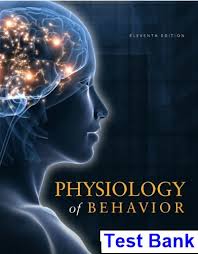Description
Test Bank For Physiology of Behavior 11th Edition By Carlson
Chapter 6: Vision
| Topic | Question Type | Factual | Conceptual | Application |
| Anatomy of the Visual System | Multiple Choice
|
1-4,6-9, 11, 13, 15,16,18-23,25-28,30-34, 37, 39, 40-44
|
5,10,12,14,24,27,
29,35,36,38,45 |
|
| Fill-In | 1-6
|
|||
| Essay | 1-5
|
|||
| Coding of Visual Information in the Retina | Multiple Choice
|
46,47,50, 54-60,62
|
48,49,51,52,53,61 | |
| Fill-In | 7-11
|
|||
| Essay | 6,7
|
|||
| Analysis of Visual Information: Role of the Striate Cortex | Multiple Choice
|
67-72
|
63,64,66 | 65,73 |
| Fill-In | 12
|
|||
| Essay | 8
|
|||
| Analysis of Visual Information: Role of the Visual Association Cortex | Multiple Choice
|
74-77,79,81-88, 91-95,97,98,100
|
78,80,89 | 96 |
| Fill-In | 13-20
|
|||
| Essay | 9,10
|
Multiple-Choice Questions
6.1-1. In the opening vignette of this chapter, Mrs. R. suffered a stroke that impaired her ability to
- read and to write.
- recognize objects via the sense of touch.
- speak.
- recognize objects via the sense of vision.
- walk up stairs.
Difficulty: 1
Question ID: 6.1-1
Page Ref: 165
Topic: Opening Vignette
Skill: Factual
Answer: d. recognize objects via the sense of vision.
Rationale: In the opening vignette of this chapter, Mrs. R suffered a stroke that impaired her ability to recognize objects via the sense of vision.
6.1-2. A sensory receptor is specialized for the
- detection of physical events.
- coordination of movement of the hands and fingers.
- detection of specific chemicals released from other neurons.
- detection of neurohormones in the blood.
- detection of electrical changes in nearby neurons.
Difficulty: 1
Question ID: 6.1-2
Page Ref: 165
Topic: Introduction
Skill: Factual
Answer: a. detection of physical events.
Rationale: A sensory receptor is specialized for the detection of physical events.
6.1-3. A sensory receptor is a variant of a(n)
- axon terminal.
- neuron.
- motor cell.
- muscle fiber.
- skin cell.
Difficulty: 1
Question ID: 6.1-3
Page Ref: 165
Topic: Introduction
Skill: Factual
Answer: b. neuron.
Rationale: Sensory receptors are specialized neurons.
6.1-4. The human visual system is specialized to detect
- infrared radiation.
- electromagnetic radiation between 380 and 760 nm.
- ultraviolet radiation.
- all wavelengths of light.
- electrical charges associated with light particles.
Difficulty: 1
Question ID: 6.1-4
Page Ref: 166
Topic: The Stimulus
Skill: Factual
Answer: b. electromagnetic radiation between 380 and 760 nm.
Rationale: The human visual system is specialized to detect electromagnetic radiation between 380 and 760 nm.
6.1-5. Which of the following is true of the process of sensory transduction?
- Receptors show action potentials to external stimuli.
- The intensity of an external stimulus is related to the firing rate of the receptor.
- An external stimulus is converted into changes in receptor membrane potential.
- Most receptors show an action potential when stimulated with an external stimulus.
- Transduction refers to the speed at which a sensory message travels toward the brain.
Difficulty: 2
Question ID: 6.1-5
Page Ref: 166
Topic: Introduction
Skill: Conceptual
Answer: c. An external stimulus is converted into changes in receptor membrane potential.
Rationale: Sensory transduction involves the conversion of an external stimulus into changes in receptor membrane potential.
6.1-6. Visible light includes electromagnetic radiation with a wavelength of 600
- meters.
- decimeters.
- millimeters.
- micrometers.
- nanometers.
Difficulty: 1
Question ID: 6.1-6
Page Ref: 166
Topic: The Stimulus
Skill: Factual
Answer: e. nanometers.
Rationale: Visible light includes electromagnetic radiation with a wavelength of 600 nanometers.
6.1-7. The perceptual attribute of ________ best corresponds to that of the dominant wavelength of light.
- saturation
- brightness
- hue
- threshold
- contrast
Difficulty: 1
Question ID: 6.1-7
Page Ref: 166
Topic: The Stimulus
Skill: Factual
Answer: c. hue
Rationale: The perceptual attribute of hue best corresponds to that of the dominant wavelength of light.
6.1-8. The attribute of ________ best corresponds to the intensity of a light.
- brightness
- saturation
- hue
- color
- threshold
Difficulty: 1
Question ID: 6.1-8
Page Ref: 166
Topic: The Stimulus
Skill: Factual
Answer: a. brightness
Rationale: The attribute of brightness best corresponds to the intensity of a light.
6.1-9. Variation in the ________ of a light will result in variation in the perception of ________.
- wavelength; brightness
- saturation; brightness
- wavelength; saturation
- intensity; purity
- wavelength; hue
Difficulty: 2
Question ID: 6.1-9
Page Ref: 166
Topic: The Stimulus
Skill: Factual
Answer: e. wavelength; hue
Rationale: Light wavelength corresponds to hue.
6.1-10. Which of the following pairs of terms do belong together?
- saturation; rods
- sensory receptor; stimulus transduction
- hue; light intensity
- brightness; hue
- saturation; hue
Difficulty: 3
Question ID: 6.1-10
Page Ref: 166
Topic: Introduction
Skill: Conceptual
Answer: sensory receptor; stimulus transduction
Rationale: Signal transduction involves activation of a sensory receptor.

Reviews
There are no reviews yet.